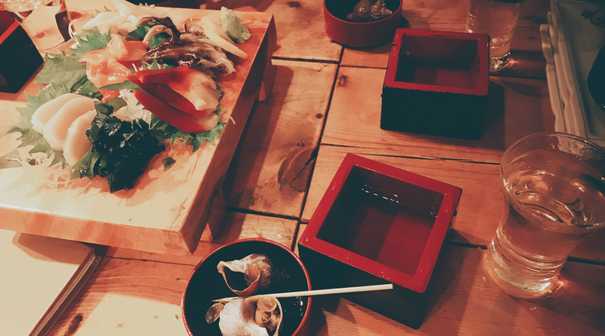5 Questions with Yuma Wada of Ninja Food Tours in Tokyo
Yuma Wada is director of Ninja Food Tours Tokyo in Japan. Yuma enjoys exploring Tokyo to discover new restaurants and hidden gems.
1. What foods is your city known for?
Tokyo offers a wide range of foods and cuisines. You will be probably overwhelmed by a large number of food options. As for traditional Japanese foods, I recommend Yakitori (Chicken skewers) and Okonomiyaki (Japanese pancakes). In addition, how these dishes are prepared is different by region in Japan. For example, Hiroshima-style Okonomiyaki has noodles in the pancakes while people put a lot of scallions in Kyoto-style Okonomiyaki pancakes.

Here is a list of foods you should try when you visit Tokyo or any cities in Japan. I do not want to overwhelm you so I limit some.
-
Sushi
-
Fresh sashimi
-
Ramen
-
Yakitori
-
Okonomiyaki
-
Grilled beef tongue (I know this is not for everyone)
-
Beef tripe stew (I know this is not for everyone)
2. What neighborhoods should people visit when they come to your city?
I will give you some recommendations:

1. Asakusa
Traditional Japanese temple and market street where you see a lot of restaurants and food vendors. Asakusa is pretty popular among tourists so you might already know this. Asakusa has been a hub for Japanese food and entertainment so if you go outside of the touristy areas, you will see very authentic restaurants and bars. Asakusa also offers a lot of Japanese comedy shows and some of them are in English if interested.
2. Shinbashi
One of the busiest business areas that offers various bars and restaurants. They are typically called izakayas (Japanese style bar) where people eat and drink after work. It is one of the most competitive areas in the food industry in Tokyo so you'll enjoy great Japanese food at a reasonable price. Some places are really popular so I recommend you make reservations in advance. Saturdays are less busy and a lot of places are closed on Sundays because nobody works in Shinbashi (People commute to Shinbashi to work).
3. Shinjuku
Its station, Shinjuku station is one of the busiest stations in the world as Tokyo's transportation hub. Shinjuku is famous for its neon town Kabukicho; a red-light and entertainment district. There are a lot of food options in Shinjuku and you'll tend to see a lot of chain restaurants. There are also historically reserved areas since world war II staying away from the redevelopment of the city. You'll need some research before going to Shinjuku to eat otherwise you may be overwhelmed and end up eating at one of those ordinary chain restaurants, which some people say are still good (I do not personally recommend though).
3. What is the best time of year to visit your city?
Japan offers four seasons and each season offers you different things so you can visit Tokyo any time. Here is why:
1. Spring
The weather gets moderate and you will see cherry bloom anywhere in the city. Ueno Park, Yoyogi Park, and Nakameguro are some popular spots for cherry blossom viewing in April. Some types of seafood taste better in this season such as Bonito, amberjack, baby squid etc.
2. Summer
The weather gets hot and humid, especially in August. However, you will get to see summer festivals and fireworks almost every week. As for food, you should try abalone, horse mackerel, cold ramen, and shaved ice.
3. Fall/Winter
You get to enjoy different types of activities in Tokyo in fall and winter such as autumn leaves viewing and hot springs (not limited to winter though). You should try oysters, yellowtail, and hot pots in Tokyo during this season.
4. What can people expect on your food tours?
We offer food and cultural food tours in Tokyo. Each tour lasts for about 2-3 hours journeying through Tokyo's neighborhoods. We spend a lot of time exploring non-touristy areas and evaluating local food vendors as we believe that people can visit touristy areas on their own. We introduce you to Japanese history and culture while letting you try great local foods at mostly family-owned restaurants which meet our standards.

Here are some tours that we offer:
1. The Best of Izakaya Tour: We take you to hidden gems in Shinjuku, one of the busiest areas in Tokyo while visiting some historical places to feel the history and culture on the tour. The restaurants are carefully selected a bit outside of busy areas and it requires some walking (30 mins including historical spot visits). The tour starts at 5 pm daily for 3 hours.
2. Asakusa Food Hunt: You will explore the greater part of Asakusa outside of the famous temple and market street. Asakusa has been a hub for food and entertainment for such a long time and it is worth spending extra time to discover Asakusa that only locals know at family owned restaurants. The tour starts at 11:30 am for 2 hours.
5. Do you see any new food trends in your city?
The food industry in Tokyo is very competitive in Tokyo as there are always new restaurants in popular neighborhoods.
In my view, Tokyo is a bit behind for vegetarian or vegan food compared to other big cities such as New York and London. It is very hard to find vegetarian restaurants when you go out to eat in Tokyo. However, the situation has been changing rapidly with newly opened chopped salad restaurants and other organic food vendors.

